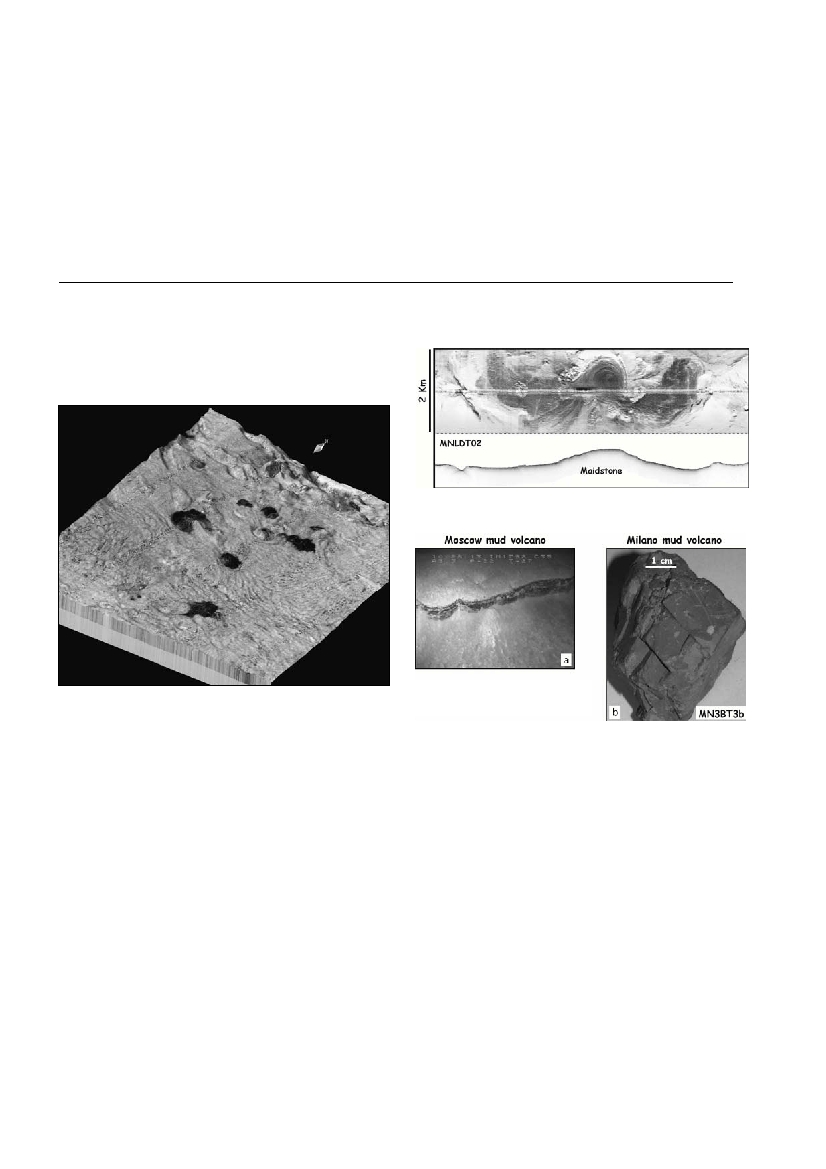Rapp. Comm. int. Mer Médit., 36,2001
27
The top of the Mediterranean Ridge (MR), in Eastern
Mediterranean, is covered by abondant sub-circular bathymetric fea-
tures (Fig.1), made of heterogeneous and heterometric clasts in a
c
l
a
y
ey matrix (2) and commonly known as "mud volcanoes" according
to their morphology. Over the Central MR, the distribution of these fea-
tures is now relatively well know (3, 4) and their genetic relationships
with backthrusting (1) as well as with thrusts and transcurent features
(5) are well imaged, at a regional scale, by swath-mapping data.
Integration of these data with ORE-Tech near-bottom side scan
sonar records over some of these mud features (M
EDINETH
survey,
1999) allow to image in details these mud-generated constructions and
their successive mud ?ows, as well as associated brines and carbonate
crusts (Fig. 2). They also stress the contrast between small weakly
re?ective subcircular mud domes (1-2 Km in diameter) and large high-
ly re?ective "mud volcanoes" (5). Deep-tow complementary profiles
provide new observations of the relationships between mud construc-
tions and tectonics, particularly potential in?uence of strike-slip fault-
ing. Several examples of mud domes connected with potential riedel-
type secondary faults are evidenced.
TheM
EDINAUT
survey (1998), has yielded new near-bottom in-situ
observations and rock samples on a few characteristic mud domes,
through 20 dives performed with the submersible Nautile. Analysis of
videos provides additionnal images of successive mud ?ows, associat-
ed ?uid seeps and close associations with active tectonic features; fault
escarpments are clearly seen during these dives in connection with
mud ?ows and mud volcanoes (Fig. 3a). Moreover, detail studies of
clasts sampled during these dives, help to precise some characters of
mud expulsion mechanisms, and subsequent evolution of mud volca-
noes. For example, the composition and age gives data concerning
paleoenvironmental conditions of deposition, detailled microstructural
study shows close control of the clast shapes by early microfractures
(Fig. 3b). Subsurface alterations seen on most of the samples are
indicative of complex cold-seep context related to mud expulsion.
In summary, a clear tectonic control of mud volcanoes is well sup-
ported at a regional scale (the entire sedimentary prism), as well as at
a local scale according to near-bottom side scan sonar records and
deep dives observations.
References:
1 - Cita, M.B., Ryan, W.B.F. & Paggi, L. 1981. Prometheus mud breccia.
An example of shale diapirism in the Western Mediterrranean Ridge,
Annales géologiques des pays Helléniques, 543-569.
2 - Fusi N. and Kenyon N. H. 1996. Distribution of mud diapirism and
other geological structures from long-range sidescan sonar (GLORIA)
data, in the Eastern Mediterranean Sea. Marine Geology, 132, 21-38.
3 - Hieke, W.,Werner, F. and Schenke, H.W. 1996. Geomorphological
study of an area with mud diapirs south of Crete (Mediterranean Ridge),
Marine Geology, 132, 63-93.
4 - Camerlenghi, A., Cita, M.B., Hieke, W. and Ricchiuto, T. 1992.
Geological evidence for mud diapirism on the Mediterranean Ridge
accretionary complex, Earth Planetary Science Letters109, 493-504.
5 - Huguen, C., Mascle, J., Chaumillon, E., Kopf, A. and Woodside J.,
submitted.Tectonic control on Mud Volcanoes: Evidence from the
Central and Eastern Mediterranean Ridge.
TECTONIC CONTROL OF MUD VOLCANOES FROM THE CENTRAL MEDITERRANEAN RIDGE
(SOUTH OF CRETE): A MULTISCALE ANALYSIS.
C. Huguen
1
*,T. Zitter
2
, J. Mascle
1
, J. Woodside
2
, J. Benkhelil
3
, P. Giresse
3
, J.P. Foucher
4
.
1
UMR 6526 Geosciences Azur,Villefranche sur mer, France.
2
Centre for Marine Earth Sciences, Free University, De Boelelaan, Amsterdam, The Netherlands
3
L.S.M., Université de Perpignan, Perpignan, France
4
IFREMER, DRO/GM, Plouzané - Brest, France
Abstract
Recent marine investigations over mud volcanoes of the Central Mediterranean Ridge, based on multibeam echo-sounding (P
RISMED
II
cruise, 1998), deep-tow side scan sonar (M
EDINETH
survey, 1999) and deep-dives (M
EDINAUT
cruise, 1998), illustrates obvious relation-
ships between mud expulsions on the sea-?oor and tectonic features. At a regional scale, swath-mapping data show evidences of close
genetic relationships with structural trends cutting across the Crestal domain of the ridge. Complementary near-bottom observations, and
sampling, over a few characteristic mud domes, provide new constraints of this tectonic control, and allow to precise some mechanisms
of mud emplacement.
Key
Wo
rds: Mud volcanoes, tectonic control, swath-mapping, deep-tow side scan sonar, Central Mediterranean Ridge, Eastern Mediterra
n
e
a
n
.
Fig. 1 : 3D-view ofthe Olimpi mud volcanoes field South of Crete.High
back-scatter patches indicates recent mud breccia ?ows.
Fig.2 : Ore-Tech deep-tow side can sonar profile recorded accross the
Maidstone Mud Vulcano during the M
EDINETH
cruise (1999).Variable
back-scatter strength indicate successive mud ?ows, and subcircular
Fig. 3 :Evidences of tectonic in?uen-
ce on mude volvanoes from deep
dives (Fig.3a), and on the clasts mor-

